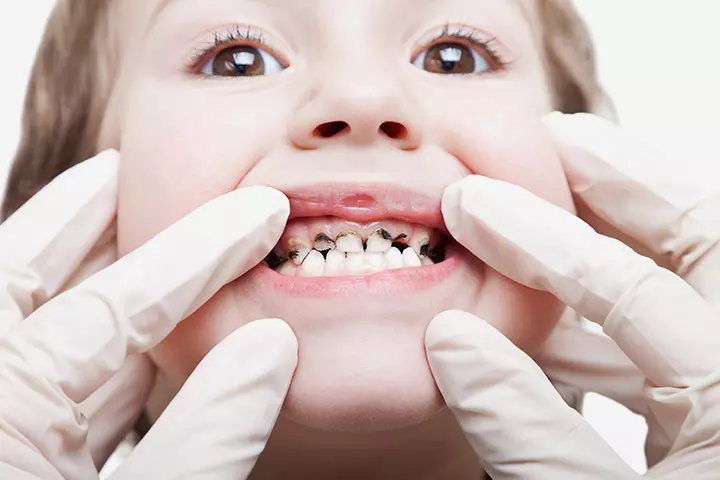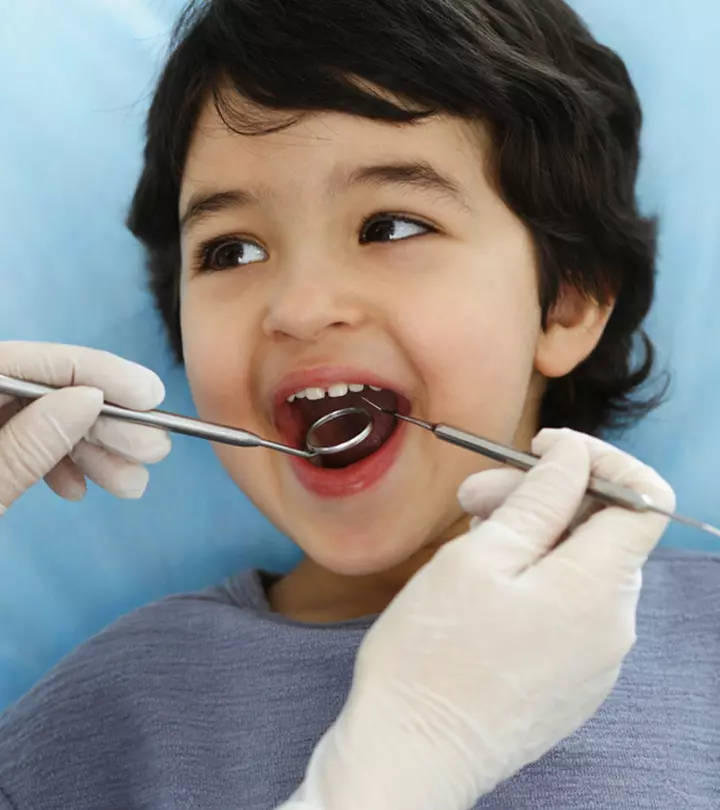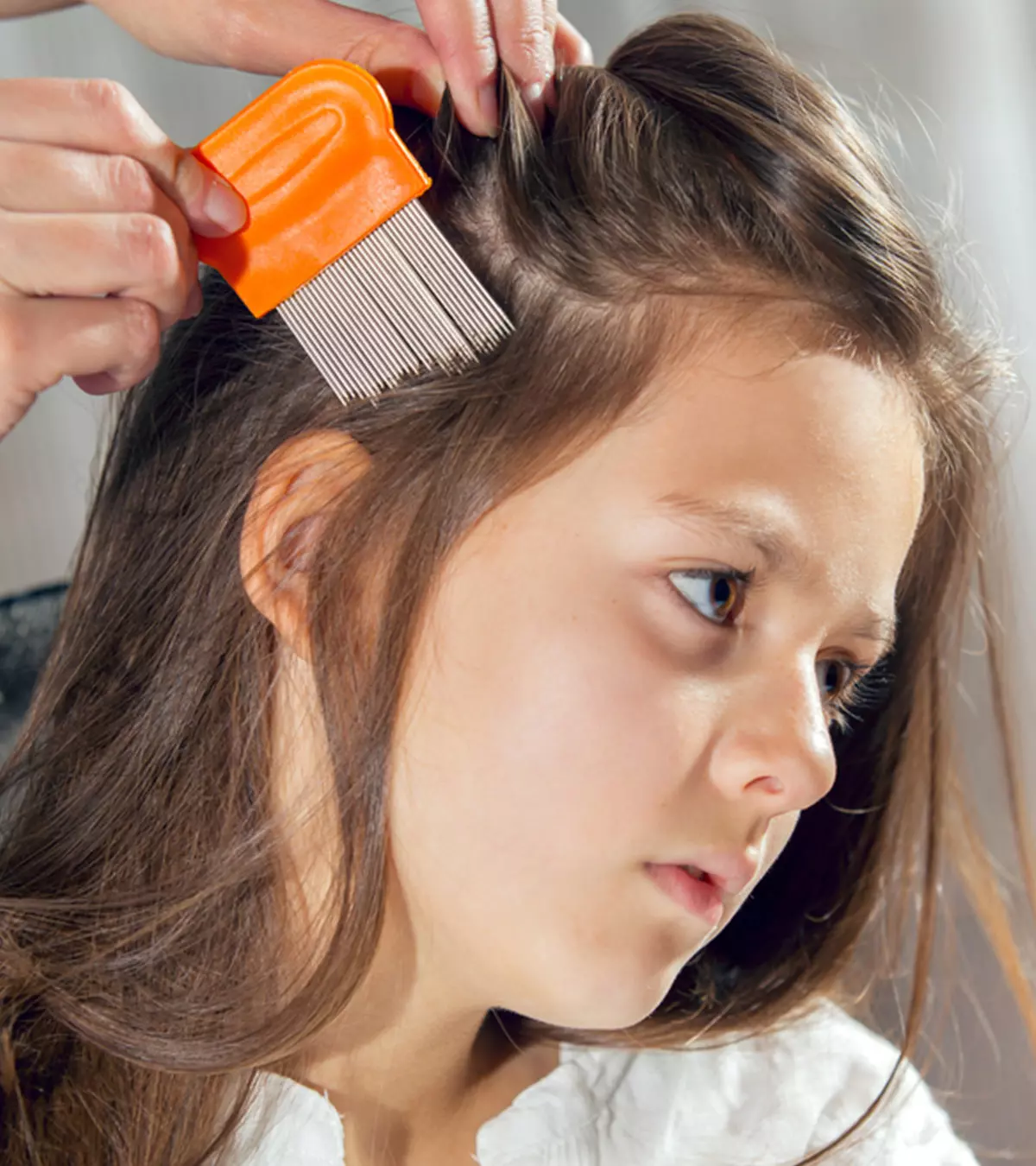Cavities In Children – Causes, Symptoms, Remedies & Solutions

When your child complains of a toothache, the first possible reason you can think of is cavities. Of course, every parent dreads cavities, but dental cavities are a fact, and as a parent, you should more know the causes, symptoms, and solutions for cavities in children.
Don’t worry though, you don’t have to search for this information. We at MomJunction, have compiled a guide to help you understand the reasons for dental cavities in children and the measures you can take for treatment and prevention. Did we just hear you sigh with relief? Possibly. But, do read on.
What Are Cavities In Children?
If your child experiences tooth decay or breakdown of tooth enamel, it will result in a hole that will grow bigger and deeper over time. The hole is the cavity or dental caries. If your child has a cavity, it is important to get it repaired by a qualified dentist. It protects the tooth and gums and also prevents complications.
[ Read: Dental Care For Kids ]
Causes Of Cavities In Children:
Our mouths are home to many bacteria. These bacteria thrive on our teeth, tongue, gums, and other places. Some bacteria are beneficial while others are harmful. It is the harmful bacteria that typically lead to cavities.
These harmful bacteria flourish when your child eats food rich in sugar and starch. The bacteria converts the sugar present in the food into acid, which erodes the enamel. The onslaught of acids causes tooth enamel to lose minerals initially. The loss appears as a white spot on the tooth and is a sign of early tooth decay. As this stage, you can stem or reverse the decay naturally, as the tooth enamel can repair itself by taking minerals from the saliva or getting fluoride from the toothpaste [1].
However, if the enamel is unable to ‘remineralize’ itself, the enamel weakens over a period and gets destroyed, leading to a hole or cavity. The cavity is permanent damage to the tooth and requires the services of a qualified dentist.
Your child is at a high risk of developing cavities if:
- He has poor oral hygiene
- He consumes a diet high in carbohydrates, sugars, and sweets
- He has low production of saliva
- He has a lot of cavity-causing bacteria in his mouth [2]
[ Read: Gum Disease In Children ]
Symptoms Of Cavities In Children:
The symptoms of cavities in kids vary, as they depend on the location of the cavity and how far along the decay is. When the cavity begins, your child will not experience any symptoms. However, as the decay continues and the hole grows big, your child may experience the following signs and symptoms:
- Toothache
- Visible holes in the teeth
- He complains of pain while biting down
- Tooth sensitivity
- Sensitivity pains while eating or drinking anything cold, hot or sweet
- There are brown, black or white stains on the surface of his teeth [3]
Most parents don’t realize that their child is developing a cavity. Hence, it is important you take your child for regular dental checkups. In case your child exhibits symptoms of cavities, it is important you schedule a dental appointment right away.
Diagnosing Cavities In Children:
When you take your child to the dentist, he may use a variety of methods to see if your little has cavities. Some of the methods that the dentist may employ to detect dental cavities include:
1. Probing The Teeth:
The dentist has a special tool called sickle probe or dental explorer. It is a sickle-shaped tool that the dentist uses to explore the tooth surface for damage and pits. However, the method is inefficient for locating cavities that are just forming. Also, when probing, the hooked end of the explorer can damage the dental enamel, giving bacteria easy access to a healthy tooth.
[ Read: Bruxism In Kids ]
2. Dental X-Ray:
When you take your child to the dentist, he may take an X-ray of your kid’s teeth to locate cavities. X-ray images can reveal newly formed cavities as well as decay that has reached the tooth pulp. Usually, there is no fixed schedule for dental X-ray, but the American Academy of Pediatric Dentistry recommends having a dental X-ray every six months.
Your dentist will let you know how often you have to bring your child to get his teeth X-rayed. The need depends on the level of oral hygiene your child maintains, including brushing and flossing, and what kind of foods he eats. You need not worry, as dental X-rays are safe and do not expose your child to high levels of radiation.
3. Liquid Dental Dyes:
This is one of the newer methods of detecting cavities in children. Here, the dentist applies a liquid dye on your child’s teeth. The dye is non-toxic and harmless, so you have no reason to be concerned. After application, the dentist will ask your child to rinse his mouth. The dye comes off from healthy teeth but stays put on areas that have decay, thus allowing the dentist to identify the teeth that need fixing.
[ Read: How To Deal With Chipped Tooth In Child ]
4. Dental Lasers:
This is a high-tech device to detect extremely early-stage dental decay. With the help of lasers, dentists can pinpoint accurately the teeth that have early tooth decay. Dentists can reverse decay at this stage by ‘remineralizing’ the dental enamel.
Once cavities form, there is no way of reversing the decay. If your child does not get the right treatment, the cavities will enlarge and deepen, leading to pain, a sore throat, and hordes of other complications.
Treatment & Solutions For Cavities In Children:
The treatment for cavities in children depends on the tooth that is decayed and the extent of the decay. Some of the treatment measures that a dentist offers for the kids with cavities include:
1. Fluoride Treatment:
If the dentist identifies the decay early, before holes form, the dentist uses a fluoride gel or varnish to stop the decay and reverse the damage to the tooth. If the dentist decides your kid doesn’t require fluoride treatment, then he may suggest using a fluoride toothpaste to reverse the decay. Fluoride helps remineralize the tooth, thereby reversing the damage the cavity-causing bacteria wreak.
2. Dental Filling:
Once a hole or cavity forms in the tooth, there is no way to reverse the decay and damage. At this stage, the dentist will decide to fill the tooth. If the dentist uses a drill, he will numb the area. Numbing is not required if the dentist uses a laser. Before filling cavities in children, the decayed tooth material is removed completely and then filled. The filling can be a dental amalgam or composite resin.
Dental amalgam is a silver-gray filling that is made from silver, copper and other metals. Previously, Mercury was the preferred metal, but it is no longer used. Amalgam is often used for molars and premolars that are not visible to the outside world while composite resin, which is a durable, tooth-colored resin, is used to fill front teeth or any other tooth, be it molars or premolars.
3. Dental Crown:
If your child has a large cavity that does not have sufficient tooth material to support a filling, the dentist will first remove the decayed material, fill the tooth with resin and then cover the filled tooth with a dental crown. For this, your child will have to go the dentist at least twice, once to take a mold of the teeth and for the filling and second time to get the crown fixed. However, if the dentist has CAD/CAM (computer-aided design or computer-aided manufacturing) technology, he will be able to make the dental cap the same day and fix it on your child’s tooth. This saves you from bringing your child back for a second visit.
4. Root Canal:
If the decay reaches the pulp of the tooth, the other cavity treatment methods will not work. The dentist will suggest root canal to remove the decay, address any infection and then remove the damaged pulp. After that, an inert material replaces the pulp, and the entire tooth is covered with a dental crown.
A root canal is a long-drawn procedure and will require a minimum three to four visits to the dentist.
Risks and Complications Of Cavities In Children:
Thanks to the junk food and unhealthy food choices our child make today (we are guilty of giving these foods to our kids), cavities in children have become very common. This is the reason many parents do not take cavities very seriously. In fact, research shows poor oral hygiene can affect overall health, leading to infective endocarditis and respiratory problems [4].
Cavities in children can lead to serious complications, which can affect even if your child still has his milk teeth. Some of the complications that your child can develop due to untreated dental cavities include:
- Severe pain
- Abscess in the tooth
- Pus formation around the tooth
- Broken teeth
- Difficulties in chewing
- Shifting of permanent teeth in case your child loses his milk teeth prematurely due to decay
If you still neglect the decay, and the cavities become severe, your child may experience the following:
- Excruciating pain that will prevent him from attending school
- Nutritional deficiencies due to pain while chewing. This could adversely affect your child’s growth and development
- Tooth loss, causing your child to lose self-confidence and also face issues with self-esteem
- If your child develops a tooth abscess and you ignore it, it could turn into a serious infection that could be life-threatening
As you can see, cavities in children are not something that you should take lightly. Good oral hygiene and health have a profound effect on your child’s overall health and wellbeing.
Prevention Tips For Cavities In Children:
As a responsible parent, you don’t want your child to develop cavities. Thankfully, there are many ways and means to prevent your little one from getting cavities.
1. Oral Hygiene From Birth:
Dentists recommend starting oral hygiene regimen even if your little one does not have baby teeth as yet. Use a clean, warm cloth to clean your baby’s gums, tongue, and insides of the cheeks. Make it a point to do this after your feed your baby and before you put him into bed.
[ Read: Bad Breath In Children ]
2. Cleaning Of Milk Teeth:
The moment your child gets his first milk tooth, introduce him to the joys of brushing his teeth. Use a soft baby toothbrush to clean his teeth twice a day with a little bit of fluoridated toothpaste. Once your child reaches the age of 2, use a pea-size amount of toothpaste. Supervise the brushing so that your child learns to clean his teeth properly from a young age.
3. Using Fluoride:
Fluoride protects your child’s teeth by preventing mineral loss from the enamel and replacing lost minerals. It also affects the bacteria’s ability to make acids. Under normal circumstances, your kid gets his fluoride from the water he drinks and the fluoridated toothpaste he uses to clean his teeth. Sometimes, this may not be sufficient. If that happens, your dentist will suggest applying a fluoride varnish on your kid’s teeth, prescribing fluoride tablets or using fluoridated mouth rinse.
4. Supervise What Your Child Eats:
What your child eats is important for preventing cavities. Each time your child eats or drinks anything that has sugar or starch, the bacteria in the mouth become active and start feeding to produce acids that erode the dental enamel. While your child’s saliva helps to flush the mouth and ward off the attack from the acids, it will not help if your little one eats sugary and starchy foods throughout the day. That is why you need to keep an eye on what your child eats and how often he eats.
5. Tooth Brushing:
From the ages of 2 until 8, brush your child’s tooth brushing. He should not use more than a pea size of fluoride toothpaste. Make sure he spits out the toothpaste, as swallowing toothpaste could result in a serious dental condition called dental fluorosis [6]. This occurs if the high imbibe more than the recommended dosage of fluoride.
Dental fluorosis causes white lines or streaks on the teeth, causing discoloration of the teeth. It is not a disease. It causes a reduction in the mineral content of the tooth enamel.
6. Dental Sealant:
Ask your dentist about dental sealants. These plastic coatings that the dentist paints on the chewing surface of your child’s molars. This prevents the food particles from getting stuck in the pits and grooves of the tooth that the bacteria feed on. Once the uneven surfaces of the molars get covered, food particles do not get trapped, reducing the chances of cavities.
Get your child’s first permanent molars sealed when they erupt. Usually, this occurs between the ages of 5 and 7. When the second permanent molars come out between the ages of 11 and 14, get these also sealed.
7. Regular Dental Checkups:
It is important you take your child regularly for a dental checkup. Usually, you should take your child every six months, but after the initial visit, your dentist will let you know how often you should bring your child for a checkup.
The dentist will teach your child how to brush teeth correctly, the importance brushing and flossing, apply fluoride varnish if required, check for early tooth decay, and remove any buildup of plaque. Regular dental visits also take away the fear of going to the dentist should your child develop cavities or other dental issues later on.
Other Prevention Tips For Cavities In Children:
Here are some important tips for preventing cavities in children:
- Restrict the number of snacks your child consumes between meals. This reduces the acid attacks on your child’s teeth, giving them an opportunity to repair themselves
- Give your child candies, chocolates, and sugary and carbonated drinks just on special occasions
- Do not let your child indulge in fruit juices as the natural sugars in the juice provide oral bacteria the food they need to produce acids
- Do not give your child anything with sugar to eat or drink before he goes to bed. When your child sleeps, production of saliva reduces, making the teeth more vulnerable to acid attacks
Home Remedies For Cavities In Children:
Thankfully, there are home remedies that can help to prevent and treat cavities in children. Some of these remedies have scientific data to support their efficacy. However, do not rely solely on home remedies. If your child has cavities, he requires treatment by a dentist. These home treatments for cavities in children offer temporary respite from pain and inflammation and are not a long-term solution.
1. Clove Oil:
Clove has been used since time immemorial to treat dental problems. It has antibacterial, anti-inflammatory and analgesic properties, making it perfect for a toothache and preventing the spread of cavities.
Do not use clove oil without diluting, as it can burn the gums. If your child has a cavity and is experiencing toothache, dilute two to three drops of clove oil with about quarter teaspoon of sesame seed oil. Place a few drops of this concoction on a cotton ball and apply on the affected tooth. This will provide temporary relief so make it a point to schedule a visit to the dentist as soon as possible.
2. Table Or Rock Salt:
Salt has antibacterial and antiseptic properties. If your child has an infection, it can reduce inflammation, ease pain and prevent the infection from getting worse.
Dissolve one tablespoon of salt in a glass of warm water and let your child swish the salt water for a minute. Use this home remedy three times a day until your kid’s symptoms reduce. However, do take him to the dentist to repair the cavity. Otherwise, he will keep getting the pain and infection.
3. Oil Pulling:
Research shows oil pulling can reduce dental cavities [7]. However, do check with your dentist and doctor whether it is alright for your child to perform oil pulling. There is a special technique for oil pulling. So it is best used with older children, who can follow instructions. Oil pulling removes harmful bacteria from the mouth, thus preventing cavities.
Take a tablespoon of sesame oil and let your child swish it for 20 minutes in his mouth. Tell him not to swallow the oil. He should spit it out. After that, let him rinse his mouth with warm water and brush his teeth as normal. Make your child do this every morning on an empty stomach to prevent cavities.
4. Licorice Root:
Dried licorice root contain licoricidin and licorisoflavan A which are antibacterial compounds. They stop the proliferation of bacteria that cause cavities in children [8]. You can get dried licorice root powder from a health food store.
Let your child brush his teeth with the powder on a daily basis. It will prevent cavities and maintain good oral health.
5. Nutmeg:
Studies show nutmeg can prevent tooth decay and cavities [9]. It does so by eliminating cavity-causing bacteria from the mouth.
Grate a little of nutmeg and mix some oregano oil. Apply this paste on the affected tooth. Let it stay for about 10 minutes and then make your little one rinse with warm water. Use this home remedy for cavities for children three to four times a day for best results.
6. Garlic:
Garlic has antibacterial and antiseptic properties. It provides relief from pain and helps gums and teeth become healthy. This is not a home remedy that your child will love, but it can prove to be quite effective.
Crush three to four cloves of garlic with a quarter teaspoon of rock salt. Apply on the affected tooth and let it stay for 10 minutes. Rinse with mouthwash. Use this home remedy twice a day until cavities reduce. It also can provide relief from the pain.
7. Turmeric:
Ayurveda has been using turmeric for its antibacterial and anti-inflammatory properties. It can reduce incidences of cavities and also reduce pain and inflammation.
Take turmeric root and blend it into powder. Apply the turmeric on your child’s tooth and let it stay for two to three minutes. Rinse with warm water. Use turmeric twice a day for three to four days for best results.
8. Indian Lilac Or Neem:
Also known as Neem, Indian lilac can destroy bacteria that cause cavities with its potent antibacterial properties. It also keeps the gums and teeth healthy and strong.
Extract juice from the Neem leaves and make your child rub it on the gums and teeth twice a day. This juice is bitter, so beware! Your child will protest and gag, but it is effective in treating cavities.
In Conclusion:
Cavities in children are the bane of modern lifestyle and poor oral hygiene. You can take steps to prevent your child from getting cavities by ensuring he brushes and flosses his teeth twice a day, reduces his consumption of carbs, starch and sugary foods and drinks, and reduces snacking between meals. Once cavities appear, you need a dentist to fix and save the tooth before the decay worsens and affects the pulp and nerves.
How do you maintain your child’s dental health? What do you do to keep cavities at bay? We would like to hear from you so comment below and let us know your thoughts and experiences.
Recommended Articles:
- 4 Simple Tips To Teach Your Kids To Brush The Right Way
- Tooth Abscess In Children – Causes, Symptoms & Treatments You Should Be Aware Of
- 5 Serious Causes Behind Discolored Teeth In Children
- Gingivostomatitis In Children – Causes, Symptoms And Treatments





















